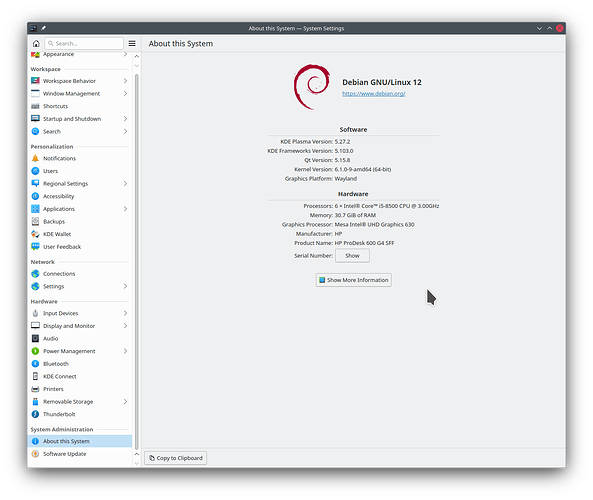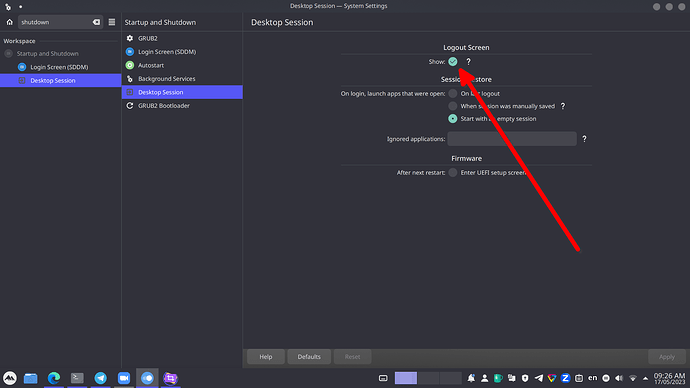Every time I try to shutdown, reboot, or log off, it has a 30 second time. I don’t need or want this timer. How can I get rid of it?
Go to System settings → Desktop Session and then uncheck that show button in logout screen section. Then you won’t get the confirmation screen with 30 seconds timeout
AHHHH. I see. Thank you.
But now I wonder, if I want to see the buttons, but only have a 5 second timeout…how can I do that? Can I do that?
You cannot; not without changing the code, at least.
Edit file
/usr/share/plasma/look-and-feel/org.kde.breeze.desktop/contents/logout/Logout.qml
Edit
property real timeout: 30 to property real timeout: 5 if you want 5 seconds. (Open the file with Kate then save as sudo when saved if you have trouble with editing system file.)
Or
apt-get install sd
sd "30" "5" /usr/share/plasma/look-and-feel/org.kde.breeze.desktop/contents/logout/Logout.qml
Reference: https://www.pclinuxos.com/forum/index.php?topic=153588.0
And keep in mind that this customization will get blown away with every system update and need to be re-applied.
Do you know if there are plans to make this a user customizable setting later? 30 seconds is a long time.
Not to my knowledge. What’s the problem with the 30-second timer?
Seconds is a long time. If I am sitting at my desk and I go to reboot, I’d need to see that screen for 5 seconds, 10 seconds max. 30 seconds is a bit long IMHO.
And it seems strange for an operating system that is all about customization, that we can’t customize the info screen timer. Especially since there is a configuration setting for it. I’d assume the setting would be exposed for customization through a UI and/or someway for per-user override such that updates don’t break it.
Seconds is a long time. If I am sitting at my desk and I go to reboot, I’d need to see that screen for 5 seconds, 10 seconds max. 30 seconds is a bit long IMHO.
…But… you don’t…
If you’re actually sitting there then just click the Ok button on the logout screen or hit the return key. The timer is just there to catch the case of people who click “shut down” (or whatever) and then walk away from their computer because they’re unaware that there’s a confirmation screen. Just pretend there is no timer and click Ok to confirm the action you want to do.
Eh. I get what you’re saying, but I’d still much prefer being able to customize it and have it stick. I mean, having more control of my OS experience was one of the drivers for moving away from Windows. If we lose the ability to customize things, then, IMHO, some of the value of Linux is gone.
But that’s just my opinion/thoughts.
Consider, for every option to customization:
-
There is a possibility that it introduces bugs, maybe not now but in a few years when nobody remembers that option. That will be hard to debug then.
-
Someone is complaining that there is to many options / settings are to cluttered with options and they should remove more options.
The Devs can’t make everyone happy that’s just not possible.
Funnily enough I only realised while reading this thread that it is a confirmation screen. I always thought KDE was ignoring my initial selection of “shutdown” vs “restart” etc. from the menu and asking me to click on it a second time, full-screen. Guess I should have looked at it for longer. ![]()
Yeah, I can respect that. I mean, in the grand scheme of things, this is the smallest.
But I still think Linux could stand to have a framework/standard for user overrides for system settings. Kinda how VS Code has default configs and then a user config file. That way system updates can do whatever they need, but user configs override.
And it doesn’t have to have a UI for it. It could be a text file that a user creates in their home folder.
For me it’s more a psychology/mentality thing. With 30 seconds, I know that I have to click the confirm button if I want to restart/logout fast. With 5/10 seconds though, I kinda know that even if I don’t click confirm right away, I wouldn’t have to wait for 30 seconds to pass, I can check my phone/ect while 5/10s count down.
30 seconds makes users have more incentive to deal with the confirm button right away.
Experience shows that hidden settings like this will tend to bit-rot, break all the time, and cause other subtle issues, because 99.999% of people aren’t using them and their code paths don’t get exercised.
But avoiding that by exposing the setting in the UI is total overkill; I don’t think it makes sense to allow something like this to be user-customizable, when there are already multiple existing ways to make the experience faster:
- Once the logout confirmation screen appears, immediately whack the return/enter key to trigger the selected option (which is the one you chose to make the screen appear)
- Disable the logout confirmation screen entirely
Yeah, I get that.
Now I’m wondering if I can hook into a system update trigger. So when/if there is a system update that modifies that setting, a trigger executes some script that changes it back to what I want.
Admitedly, my reason for wanting this is niche and probably silly for most.
For me, 99% of the time when I initate a login I’m going to intiate then get up to get water, and come back to my desk. Ideally I want the system booted back up before I’m back at my desk. If the timeout is 0 or 5 seconds, my system will be back up by the time I’m at my desk. If the timeout is longer than 10 seconds, then it won’t.
Now, I could turn it off entirely.
But 1% of the time I do want to see that screen cause I want to do something else.
Obviously I could fix this by changing my workflow but I’m of the school of thought that computers bend to me, not the other way around. ![]()
Yeah, you’ll need to come up with something to re-apply local patches when updating the system. Gentoo includes such a thing, AFAIK. But of course, if you’re not already using Gentoo, switching to it simply to change the auto-accept timeout on a confirmation screen that is itself optional and can be dismissed instantly by whacking the Enter key seems like overkill too. ![]()
The space bar works too; I find it easier to hit as I’m getting out of a chair.
Might be easier to modify pakbak (Arch and cousins), or create your own systemd .path etc. along its model.

